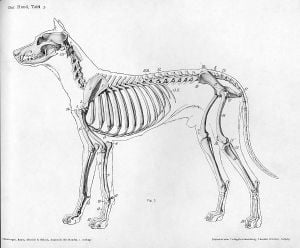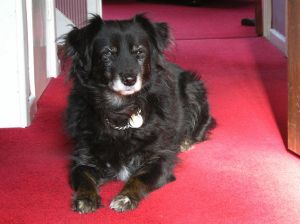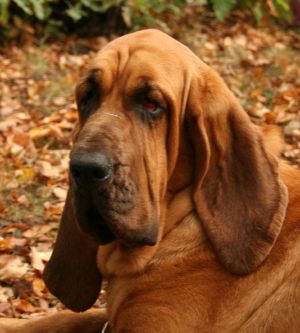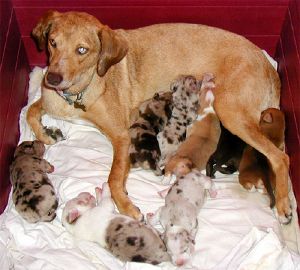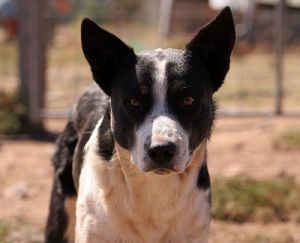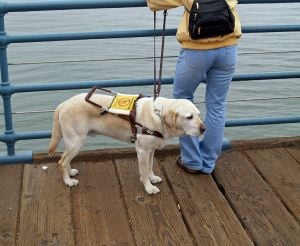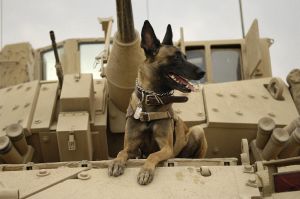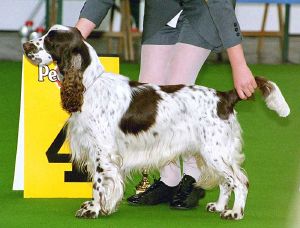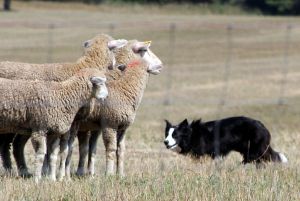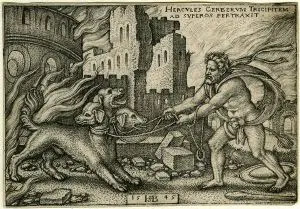Dog
| Domestic dog
| ||||||||||||||||||
|---|---|---|---|---|---|---|---|---|---|---|---|---|---|---|---|---|---|---|
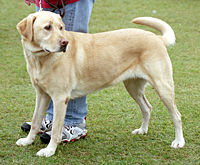 | ||||||||||||||||||
|
Conservation status: Domesticated
| ||||||||||||||||||
| Scientific classification | ||||||||||||||||||
| ||||||||||||||||||
| Canis lupus familiaris |
The dog (Canis lupus familiaris or Canis familiaris) is usually considered to be humankind's first, and perhaps most important, domestic animal. It generally is classified as a subspecies of the gray wolf (Canis lupus), a mammal of the Canidae family of the order Carnivora.
The word "dog" also is used to refer to some other members of the Canidae family, for instance the bush dog (Speothos venaticus) of South America and the raccoon dog (Nyctereutes procyonoides) of Asia. The family Canidae itself often is called the "dog family" and includes jackals and coyotes, which are closely related to dogs and wolves, as well as foxes, which are less closely related. Members of the Canidae family are called "canids."
The trainability, devotion, playfulness, and ability to fit into human households have earned dogs a unique position in the realm of interspecies relationships. Dogs have lived and worked with humans in so many rolesâhunting, herding and protecting sheep and cattle, guarding people and property, rescuing people, companionship, and so forthâthat their loyalty has earned them the unique sobriquet, "man's best friend." Their actions mimic the human idea of love and friendship, leading many dog owners to view their pets as family members.
In a process generally thought to span at least 14,000 years, humans have domesticated the dog, produced innumerable breeds, and bred and trained them to perform a great variety of useful services and sometimes dubious actions, including as guard dogs trained to instill fear in people and as sports dogs taught to fight other dogs to the death.
Characteristics
Dogs, like wolves and other canids, are specialized for a life of hunting and eating other animals. Their bodies are compact and muscular and their legs are long, which gives them speed and endurance for chasing prey. Their jaws are large and their teeth are well suited for grasping, biting, and tearing flesh. Their digestive systems, however, are suited for some plant foods as well as flesh.
Most dogs are covered with a thick coat of fur, which protects them from the elements. Alaskan malamutes and Siberian huskies, which originated in the Arctic, are able to live outside without shelter in temperatures far below freezing. Dogs' coats come in a wide range of colors, including black, white, brown, yellow, red, and gray. They come in a range of lengths and textures from very short to long, either straight or curly (AKC 2006).
A dog's heart and lungs are oversized relative to its body and its normal everyday needs. A dog also has relatively more red blood cells than a human. Most of the time the dog will keep the extra red blood cells stored in its spleen. When the animal enters into a situation where its full metabolism is required, such as play, catching game, or fighting other dogs, the extra cells are released into the bloodstream. The "oversized" heart and lungs would then be running at full capacity, and the animal would have an enhanced ability to engage in aerobic activity. This activity produces internal heat. Dogs, being covered in fur, are limited in their ability to cool down. After a short time the animal must either cease its athletic activity or risk harming itself from overheating. One can easily observe this pattern of intense activity followed by rest periods in puppies. During the rest phase, the spleen collects red blood cells and the animal may pant to cool down.
Dogs, like most carnivores, are naturally active only 4 to 6 hours each day and prefer to sleep the rest of the time (Kruuk 2002).
Dogs, like other canids, are considered to be among the most intelligent of all animals, as shown by their ability to adapt to changing conditions in human society.
The dog's ancestor, the gray wolf, is the largest canid; with adults weighing between 18 and 80 kg (40 to 175 lbs). Modern dogs can weigh anywhere from 1 to over 100 kg (2.2 to 220 lbs). Dingos, wild dogs of Australia which are descended from domestic dogs, average 10 to 20 kg (22 to 44 lbs) in weight (Nowak 1983).
Senses
Sight
In general, the vision of dogs is not as good as that of humans. They have only limited color vision, equivalent to red-green color blindness in humans (Alderton 1984). They also are nearsighted compared to humans and can not see detail as well. The average dog's vision seems to be about 20/50 to 20/100, using the human standard. On the other hand they see better in dim light and may also detect motion better than humans (Davis 1998).
Hearing
The hearing of dogs is superior to humans. They can detect sounds that are lower and those that are higher in frequency. They also have a degree of ear mobility that helps them to rapidly pinpoint the exact location of a sound. Eighteen or more muscles can tilt, rotate, and raise or lower a dog's ear. Additionally, a dog can identify a sound's location much faster than a human can, as well as hear sounds up to four times the distance that humans are able to. Those with more natural ear shapes, like those of wild canids, generally hear better than those with the floppy ears of many domesticated species.
Smell
Dogs have nearly 220 million smell-sensitive cells over an area about the size of a pocket handkerchief (compared to 5 million over an area the size of a postage stamp for humans). Some breeds have been selectively bred for excellence in detecting scents, even compared to their canine brethren.
What information a dog actually detects when it is scenting is not perfectly understood. Although once a matter of debate, it now seems to be well established that dogs can distinguish two different types of scents when trailing: An air scent from some person or thing that has recently passed by, as well as a ground scent that remains detectable for a much longer period. The characteristics and behavior of these two types of scent trail would seem, after some thought, to be quite different, the air scent being intermittent but perhaps less obscured by competing scents, whereas the ground scent would be relatively permanent with respect to careful and repetitive search by the dog, but would seem to be much more contaminated with other scents. In any event, it is established by those who train tracking dogs that it is impossible to teach the dog how to track any better than it does naturally; the object instead is to motivate it properly, and teach it to maintain focus on a single track and ignore any others that might otherwise seem of greater interest to an untrained dog. An intensive search for a scent, for instance searching a ship for contraband, can actually be very fatiguing for a dog, and the dog must be motivated to continue this hard work for a long period of time.
Reproduction
In domestic dogs, sexual maturity (puberty) begins to happen around age 6 to 12 months for both males and females, although this can be delayed until up to two years old for some large breeds. Adolescence for most domestic dogs is around 12 to 15 months, beyond which they are for the most part more adult than puppy. As with other domesticated species, domestication has selectively bred for higher libido and earlier and more frequent breeding cycles in dogs than in their wild ancestors.
Dogs bear their litters roughly 9 weeks after fertilization, although the length of gestation can vary from 56 to 72 days. A general rule of thumb is that a mammal will produce half as many offspring as the number of teats on the mother. This rule is altered in domesticated animals since larger litters are often favored for economic reasons and in dogs, particularly, the great range of sizes and shapes plays a role in how many healthy puppies a female can carry. An average litter consists of about six puppies, though this number may vary widely based on the breed of dog. Small dogs generally produce from one to four puppies in each litter, while much larger breeds may average as many as 12 pups in each litter. The number of puppies also varies with the mother's age and health, the father's sperm count, the timing of the breeding, and many other factors.
Lifespan
The typical lifespan of dogs varies considerably by breed. For example, many giant dog breeds (such as great danes) average only 7 or 8 years, while some small terrier breeds, or toy breeds, might live to be older than 20. The average lifespan for mixed-breed and midsize dogs is about 13 to 14 years. The longest-lived dog with reliable documentation died at 29 years and 27 days; the breed of the dog was an Australian cattle dog and it lived in Virginia, United States, with the date of death in 1939. Although the lifespans of all living species are mostly uncontrollable, one can significantly extend a dog's life by feeding it the right kinds of foods, giving it regular exercise, treating its diseases, caring for its special needs, and giving it love and comfort.
Social behavior
Dogs, like almost all canids, are social animals. Wolves, and it is assumed the ancestors of dogs, almost always live in pairs, a male and a female with their young, or in larger groups called packs. Within the pack, the individual animals communicate with each other by visual signals, such as body and facial expressions and tail wagging, as well as by vocal signals, such as growls and howls. Pack members sometimes hunt individually and sometimes as a group, depending on the situation, including the size of the prey (Kruuk 2002).
The members of the pack cooperate in many activities, such as hunting, caring for the young, and defending their territory from intruders. Within each pack, there is a dominant pair which takes the lead, while the others support them. In most cases, only the dominant pair reproduces. Wolves struggle to establish dominance and sometimes fight with each other, but this seldom leads to serious injury or death since the losing animal will display submissive behavior which discourages further attacks. Studies of feral dogs have found that they often form packs of 3 to 5 individuals (Clutton-Brook 1999; Nowak 1993; Voelker 1986).
Origins
According to recent genetic research, the lineage of dogs separated from that of wolves about 100,000 years ago (Wayne 1997). It is not known when the ancestors of dogs began to associate with humans. The first fossil evidence of domesticated dogs, which had changed in physical form from their wolf ancestors, dates from around 15,000 years ago. Dog fossils from about this time have been found in Asia, Europe, North America, and South America (Clutton-Brock 1999).
Other genetic research seems to indicate that China was the site of the original domestication of dogs (McGourty 2002). Genetic research has identified 14 ancient dog breeds, with the oldest being the Chow Chow, Shar Pei, Akita Inu, Shiba Inu, and Basenji. Many of the 14 breeds are associated with China and Japan (Savolainen 2002).
Human relationships
Dogs are highly social animals. This can account for their trainability, playfulness, and ability to fit into human households and social situations. This similarity has earned dogs a unique position in the realm of interspecies relationships.
The loyalty and devotion that dogs demonstrate as part of their natural instincts as pack animals closely mimics the human ideas of love and friendship, leading many dog owners to view their pets as full-fledged family members. Conversely, dogs seem to view their human companions as members of their pack, and make few, if any, distinctions between their owners and fellow dogs.
Dogs fill a variety of roles in human society and are often trained as working dogs. For dogs that do not have traditional jobs, a wide range of dog sports provide the opportunity to exhibit their natural skills. In many countries, the most common and perhaps most important role of dogs is as companions or pets. In the United States, about 36 percent of households own at least one dog, with the total number of animals about 62 million (AVMA 2002).
Dogs have lived and worked with humans in so many roles that their loyalty has earned them the unique sobriquet, "man's best friend."
Terminology
The English word "dog," in common usage, refers to the domestic pet dog, Canis lupus familiaris. The species was originally classified as Canis familiaris by Linnaeus in 1758. In 1993, dogs were reclassified as a subspecies of the gray wolf, Canis lupus, by the Smithsonian Institution and the American Society of Mammalogists.
The English word "dog" might derive from the Old English "docga," a "powerful breed of canine," like the modern mastiff. The English word "hound" is a cognate of German Hund, Dutch hond, common Scandinavian hund, Icelandic hundur, which, though referring to a specific breed in English, means "dog" in general in the other Germanic languages. "Hound" itself derives from the Proto-Indo-European *kwon-, which is the direct root of the Greek ÎșÏ ÏÎœ (kuĆn) and the indirect root of the Latin canis through the variant form *kani-.
In breeding circles, a male canine is referred to as a "dog," while a female canine is called a "bitch." The father of a litter is called the "sire," and the mother of a litter is called the "dam." Offspring are generally called "pups" or "puppies" until they are about a year old. A group of offspring is a "litter." The process of birth is "whelping." Many terms are used for dogs that are not purebred.
The constellations Canes Venatici, Canis Major, and Canis Minor are named from the Latin word for "dog," for their perceived resemblance to dogs. Sirius, the brightest star in the sky as seen from earth, is called the "dog star" because it is found in Canis Major. The time when Sirius rises just before sunrise, mainly July and August, are called the "dog days of summer."
Breeds
Different breeds of dogs emerged over time due to environmental factors and human selection. In ancient Egypt, dogs looking like the modern greyhound and the mastiff are pictured in art. In ancient Roman writings, miniature pet dogs like modern toy breeds are mentioned (Clutton-Brook 1999).
There are said to be over 450 different dog breeds in the world. As of 2006, the American Kennel Club recognized 153 breeds, divided into 7 groups (AKC 2006):
- Sporting breeds were originally bred and trained to assist gun-wielding hunters in finding and recovering birds and other small game. They include various pointers, spaniels, and retrievers.
- Hounds were bred to track and engage larger hunted animals. They include the bloodhound, the English foxhound, and the beagle.
- Working breeds were bred for various tasks; such as guarding people, livestock, and property; pulling sleds; and rescuing people from water or snow. They include the rotweiler, the saint bernard, and the akita.
- Terriers were originally bred to catch and kill small animals, especially rats, without the help of a human hunter. Popular terriers include the airedale terrier and the Parson Russell terrier (also called the Jack Russell terrier).
- Toy Breeds are smaller dogs bred to be pets. They include the pug, the pekingese, and the chihuahua.
- Non-sporting breeds are medium-sized or large dogs bred to be pets, or in the case of the dalmation, a companion to horses. The poodle is one of the most popular non-sporting breeds.
- Herding breeds were bred to herd sheep or cattle. They include the collie, the German shepherd, and the Old English sheepdog.
Through history different dog breeds have gone in and out of fashion. In England, the King Charles Spaniel fell out of favor in 1689 when the house of Stuart was overthrown in the Glorious Revolution and was reborn in the twentieth century as the Cavalier King Charles Spaniel. In the United States, the beagle became very popular in the 1960s because of the cartoon character Snoopy. The most popular breed in the United States today is the Labrador retriever (AKC 2006).
Mixed breed dogs
The majority of dogs in the world are of mixed breed or no definite breed. It is estimated that 60 percent of dogs in the United States are mixed breeds, and the number it thought to be much higher in poorer countries. Advocates of mixed breed dogs as working dogs and pets say that they are more intelligent and have fewer health problems than purebreds (Kilcommons 1996).
Working, utility, and assistance dogs
The first ways that dogs were useful to humans were as helpers in hunting and as protectors. These roles grew out of the dogs' natural instincts. As time went on, dogs were trained to perform other tasks and were specially breed to do so. Some of the modern types of working dogs are:
- Assistance dogs help the seeing and hearing-impaired. Others are trained to help those with epilepsy and psychiatric disorders, by detecting the onset of the condition so they can seek help. The typical assistance dog is a sociable breed such as a Labrador retriever. In the United States, people with assistance dogs are guaranteed access to public places by law.
- Detection dogs are trained to, and work at, using their senses (almost always the sense of smell) to detect substances such as explosives or illegal drugs.
- Guard dogs are trained to protect people and property. These are commonly doberman pinschers, German shepherds, and rottweilers, or mixes of these breeds. Guard dogs differ from watch dogs in that they are expected to engage an intruder, while watch dogs are only expected to bark to alert the property owner.
- Herding dogs are trained to control livestock in the range. Sheepdogs and collies are common breeds.
- Hunting dogs search for and retrieve game. Pointers and retrievers are typical hunting breeds.
- Police dogs, typically German shepherds, are trained to assist law enforcement officers, often apprehending fleeing suspects. Schutzhund is a special test developed in Germany in the early 1900s to test if a German shepherd has the right talents and temperment to be successfully trained as a police dog.
- Rescue dogs are those that search for missing humans. The archetypal breeds are the Saint Bernard and the bloodhound, although any dog with a good sense of smell can be trained to perform this task. One of the most famous dog rescues in history is that of Napoleon Bonaparte, a poor swimmer, who fell into the ocean one night in 1814, and was rescued by a Newfoundland.
- Show dogs do tricks for the entertainment of audiences. Poodles and American Eskimo dogs were very popular as show dogs in circuses and traveling shows in the past. Now many types of dog perform in movies and television.
- Therapy dogs, with friendly and gentle temperaments, are trained to provide comfort and affection to hospitalized and institutionalized patients. The modern concept of the therapy dog was begun in 1976 by Elaine Smith, an American nurse.
- War dogs are used by the military to detect mines and enemy soldiers. War dogs, looking much like modern mastiffs, are pictured in ancient Assyrian art. Dogs continued to be used in war through Roman and Medieval times. In 1560, Queen Elizabeth I of England sent 8,000 war dogs, equipped with spiked collars and coats of mail, with her army sent to Ireland to suppress a rebellion (Kilcommons 1996). In World War II, the Soviet army trained dogs to carry explosives and run under enemy tanks, blowing them up.
Show and sport (competition) dogs
Owners of dogs often enter them in competitions, whether show (breed conformation shows) or sports, including dog racing and dog sledding. The winners garner both prestige and prize money. These dogs are often bred specifically for competition, which may not be entirely beneficial for the breeds, due to the magnification of hereditary defects.
- Dog agility is a sport in which dogs complete a timed obstacle course. It is a fairly new sport, started in 1978 in the United Kingdom.
- Tracking trials encourage dogs to make use of their strongest facility by emulating the finding of a lost person or article in a situation where the performance of the dog can be fairly assessed. Because of this, the tracks laid are not the wanderings, which may characterize a lost person, nor do they include deliberate attempts by the tracklayer to deceive the following dog.
- Dogsled racing is a winter sport where a team of dogs pull a sled and driver (called a musher). The Iditarod Trail Sled Dog Race is perhaps the most famous of these races. Dog sledding is an ancient form of transportation and still a very effective way of moving freight across this type of terrain. Most modern dog sledders use mixed breed dogs.
- Dog racing, almost always emphasizing greyhounds, involves dogs racing at betting tracks in a sport not unlike horse racing, reaching speeds of 40 miles per hour. Elsewhere, dachshunds are often raced, as a humorous sidelight in charity events.
- Dog fighting and dog baiting are blood sports involving dogs. In the past, they were very popular but now they are illegal in most jurisdictions, but are still occasionally performed underground. Some of the breeds which have been used in dog fighting are the akita, the Irish terrier, and the American pit bull terrier (often called the pit bull).
- Disc dog is the more generic name for what is commonly called Frisbee dog. In disc dog competitions, dogs and their human disc throwers compete in events such as distance catching and somewhat choreographed freestyle catching. The sport celebrates the bond between handler and dog, by allowing them to work together. The term "disc" is preferred because "Frisbee" is a trademark (held by Wham-O) for a brand of flying disc.
- Flyball is an event in which teams of dogs race against each other from a start/finish line, over a line of hurdles, to a box that releases a tennis ball to be caught when the dog presses the spring loaded pad, then back to their handlers while carrying the ball. Flyball has become popular because it is a sport in which all sizes and breeds of dog can compete.
- Sheepdog trials (or simply dog trials) are competitive events in which herding dog breeds move sheep around a field, fences, gates, or enclosures as directed by their handlers. Such events are particularly associated with hill farming areas, where sheep range widely on largely unfenced land. These trials are popular in the United Kingdom, Ireland, South Africa, Canada, the United States, Australia, New Zealand, and other farming nations. Some venues allow only dogs of known herding breeds to compete; others allow any dog that has been trained to herd.
- Earthdog trials test dachshunds and small terriers for their working abilities and instinct. Earthdog den trials involve underground tunnels that dogs must negotiate, while scenting a rat, the "quarry." The dog must follow the scent to the quarry and then "work" the quarry. Depending on the sanctioning organization, âworkingâ means barking, scratching, staring, pawing or such at it, although the quarry is protected at all times.
- Field trials are highly competitive events at which hunting dogs compete against one another. Field trials are organized by kennel clubs or other gun dog organizations.
- Obedience trials are events in which a dog must perfectly execute a predefined set of tasks when directed to do so by its handler. Obedience competition provides an opportunity for a person and a dog to work as a highly tuned team.
- Dog shows involve purebreds entered in conformation dog show and evaluated by how closely they match the ideal characteristics of the breed. The Westminster Kennel Club Dog Show is one of the most famous of this type of competition.
Dogs in research
Dogs have long been used as subjects of scientific research. In the 1890s, the Russian scientist Ivan Pavlov used dogs to study psychological conditioning. Much of the research which led to the discovery of insulin and to the successful treatment of diabetes in humans was carried out using dogs as experimental subjects. On November 3, 1957, a Russian dog, Laika, became the first animal to orbit the earth.
Dogs presently make up only a small percentage of animals used in research; rats and mice far outnumber them. However, they are especially important in medical studies, for instance on the effects of drugs. Among the reasons for this are their fairly large size and their ease in being taken care of and controlled.
Beagles are especially popular for research because of their calm and friendly nature. Most research beagles are especially bred for this purpose. Other research dogs are obtained from various sources including pound seizure, newspaper ads, strays, and lost or stolen pets. Over the years there have been protests against the treatment of research dogs and laws have been passed to protect them, and in some cases to prevent former pet dogs from being used in research (HSUS 2007).
Dog health
Dogs are susceptible to various diseases, ailments, and poisons, some of which effect humans in the same way, others of which are unique to dogs.
Diet
At present, there is some debate as to whether domestic dogs should be classified as omnivores or carnivores, by diet.
The classification in the Order Carnivora does not necessarily mean that a dog's diet must be restricted to meat; unlike an obligate carnivore, such as the cat family with its shorter small intestine, a dog is dependent on neither meat-specific protein nor a very high level of protein in order to fulfill its basic dietary requirements. Dogs are able to healthily digest a variety of foods including vegetables and grains, and in fact dogs can consume a large proportion of these in their diet. Wild canines not only eat available plants to obtain essential amino acids, but also obtain nutrients from vegetable matter from the stomach and intestinal contents of their herbivorous prey, which they usually consume.
Domestic dogs can survive healthily on a reasonable and carefully designed vegetarian diet, particularly if eggs and milk products are included. Some sources suggest that a dog fed on a strict vegetarian diet may develop dilated cardiomyopathy since it lacks L-carnitine (Nelson 2003), however, maintaining a balanced diet is also a factor since L-carnitine is found naturally in many nuts, seeds, beans, vegetables, fruits, and whole grains. In the wild, dogs can survive on a vegetarian diet when animal prey is not available. However it has been noted, both by observation of extremely stressful conditions such as the Iditarod Trail Sled Dog Race and by scientific studies of similar conditions, that high-protein (approximately 40 percent) diets including meat help prevent damage to muscle tissue. (This research is also true for some other mammals.) This level of protein corresponds to the percentage of protein found in the wild dog's diet when prey is abundant; higher levels of protein seem to confer no added benefit.
Spaying and neutering
In the United States, most pet dogs are spayed or neutered. Spaying is the surgical removal of the female's ovaries and uterus. Neutering is the removal of the male's testicles. Spayed and neutered dogs avoid some diseases such as breast and testicular cancer. Behaviors such as urinating in the house, running away, and aggression are also reduced; and unwanted litters of puppies are avoided, which could contribute to the problem of stray and feral dogs (ASPCA 2014).
Diseases
Infectious diseases commonly associated with dogs include rabies (hydrophobia), canine parvovirus, and canine distemper. Congenital diseases of dogs can include a wide range from hip dysplasia and medial patellar luxation to epilepsy and pulmonic stenosis. Canines can get just about anything a human can get (excluding many infections, which are species specific) like hypothyroidism, cancer, dental disease, heart disease, Addison's disease, and so forth.
Two serious medical conditions affecting dogs are pyometra, affecting unspayed females of all types and ages, and bloat, which affects the larger breeds or deep chested dogs. Both of these are acute conditions, and can kill rapidly; owners of dogs which may be at risk should learn about such conditions as part of good animal care.
Parasites
Common external parasites are various species of fleas, ticks, and mites. Internal parasites include hookworms, tapeworms, roundworms, and heartworms.
Common physical disorders
Some breeds of dogs are also prone to certain genetic ailments, such as hip dysplasia, luxating patellas, cleft palate, blindness, or deafness. As noted, dogs are also susceptible to the same ailments that humans are, including diabetes, epilepsy, cancer, and arthritis.
Environmental and health concerns
Despite the many benefits which dogs provide for humans, they also do harm. Dogs sometimes attack and bite humans. In the United States, there are about 7,000 dog attacks per year (Voelker 1986).
An even more serious problem is rabies, a viral disease that is spread by animal bites. Rabies is always fatal unless treated. The World Health Organization estimates that about 55,000 people die of rabies each year; mostly in the rural areas of Africa and Asia, and mostly because of dog bites. In Europe and North America, where most dogs are immunized against rabies, wild animal bites are the most common cause. About 10 million people each year are treated for possible exposure to rabies (WHO 2006). Rabies is an especially serious problem in India, which has about 25 million feral dogs (Sandeep 2002).
Dogs can also have a negative effect on the natural environment. In New Zealand, pet dogs allowed to run wild were found to be a serious threat to kiwis and other ground nesting birds (ISSG 2007). A study in the city of Baltimore in the United States done in the 1970s found that about half the dogs in the city were at least partly free ranging and that they also feed on ground nesting birds, although their main food source was garbage (Nowak 1983). In Africa, diseases spread by domestic dogs have contributed to the decline of endangered wild predators, such as the lion, the leopard, and the African hunting dog (Kruuk 2002).
Dogs in culture and religion

Dogs have often appeared in art since the time of ancient Egypt, where they were often included in hunting scenes painted within the tombs of important people. In Renaissance Europe, portraits often included a favorite lap dog.
Compared to some other animals, dogs have not played such an important role in religion. In Greek mythology, the underworld was guarded by a three-headed dog named Cerberus, who was later captured by Hercules. In Judaism, the dog is considered an unclean animal and when they are mentioned in the Bible they are almost always portrayed in an unfavorable light. Islam also looks on dogs unfavorably. Mohammad expressed that the company of dogs voids a portion of a Muslimâs good deeds (Malik Ibn Anas 2:969).
In Christianity, Jesus told the story of the poor man Lazarus, whose sores were licked by street dogs. This has traditionally been seen as showing Lazarus's wretched situation. However, some modern commentators have pointed out that the dogs' saliva could have beneficial effects on the sores and that this could be seen as an example of the dogs' unconditional love (Kilcommons 1996).
The Catholic Church recognizes Saint Roch (also called Saint Rocco), who lived in the early 1300s in France, as the patron saint of dogs. It is said that he caught the black plague while doing charitable work and went into the forest expecting to die. There he was befriended by a dog which licked his sores and brought him food and he was able to recover. August 16 is celebrated as the feast day of Saint Roch (Cultural Catholic 2007).
Dogs have often been mentioned favorably in literature. In Homer's Odyssey (written around 800 to 600 B.C.E.) the hero's dog Argos is the only one to recognize him on his return home in disguise. One of the greatest tributes to a dog was by the English poet Byron (1788-1824), who wrote of the Newfoundland, Boatswain (Byron 1808):
- "âŠBeauty without Vanity,
- Strength without Insolence,
- Courage without Ferocity,
- and all the Virtues of Man,
- without his Vices."
ReferencesISBN links support NWE through referral fees
- Alderton, D. 1984. The Dog. London: Chartwell Books. ISBN 0890097860
- American Kennel Club (AKC). 2006. The Complete Dog Book. New York: Ballantine Books. ISBN 0345476263
- American Society for the Prevention of Cruelty to Animals (ASPCA). 2014. Top 10 reasons to spay or neuter your pet. ASPCA. Retrieved December 18, 2014.
- American Veterinary Medical Association (AVMA). 2002. Market research statistics: Cat and dog ownership. AVMA. Retrieved August 6, 2007.
- Byron, G. G. 1808. Epitaph to a dog. Poetry Lovers Page. Retrieved August 2, 2007.
- Clutton-Brook, J. 1999. A Natural History of Domesticated Mammals. Cambridge, UK: Cambridge University Press. ISBN 0521634954
- Cultural Catholic LLC. 2007. Saint Roch. Cultural Catholic. Retrieved August 8, 2007.
- Davis, J. 1998. Color and acuity differences between dogs and humans. University of Wisconsin, Stevens Point. Retrieved August 2, 2007.
- Humane Society of the United States (HSUS). 2007. Animals used in research: Dog profile. Human Society of the United States. Retrieved August 6, 2007.
- Invasive Species Specialist Group (ISSG). 2007. Canis lupus (mammal). Invasive Species Specialist Group. Retrieved August 8, 2007.
- Killcommons, B., and M. Capuzzo. 1996. Mutts: America's Dogs. New York: Time Warner. ISBN 0446519499
- Kruuk, H. 2002. Hunter and Hunted: Relationships Between Carnivores and People. Cambridge, UK: Cambridge University Press. ISBN 0521814103
- Malik Ibn Anas, al-Muwattaâ (Egypt: al-Babi al-Halabi, n.d.), 2:969. Reported in El Fadl
- McGourty, C. 2002. Origin of dogs traced. BBC News. Retrieved July 23, 2007.
- Nelson, R. W., and C. G. Couto. 2003. Small Animal Internal Medicine, Third Edition. Philadelphia: Mosby. ISBN 032301724X
- Nowak, R. M., and J. L. Paradiso. 1983. Walker's Mammals of the World. Baltimore: The Johns Hopkins University Press. ISBN 0801825253
- Sandeep, K. 2002. Man's worst enemy. The Hindu.
- Savolainen, P., Y. Zhang, et al. Genetic evidence for an East Asian origin of domestic dogs. Science. Retrieved July 24, 2007.
- Voelker, W. 1986. The Natural History of Living Mammals. Medford, New Jersey: Plexus Publishing. ISBN 0937548081
- Wayne, R. K., C. Vila, et al. 1997. Multiple and ancient origins of the domestic dog. Science. June 13, 1997. Retrieved July 24, 2007.
- World Health Organization (WHO). 2006. Rabies. World Health Organization. Retrieved August 8, 2007.
Credits
New World Encyclopedia writers and editors rewrote and completed the Wikipedia article in accordance with New World Encyclopedia standards. This article abides by terms of the Creative Commons CC-by-sa 3.0 License (CC-by-sa), which may be used and disseminated with proper attribution. Credit is due under the terms of this license that can reference both the New World Encyclopedia contributors and the selfless volunteer contributors of the Wikimedia Foundation. To cite this article click here for a list of acceptable citing formats.The history of earlier contributions by wikipedians is accessible to researchers here:
- Dog history
- Disc_dog history
- Sheepdog_trial history
- Earthdog_trial history
- Field_trial history
- Obedience_trial history
- Tracking_trial history
- Flyball history
The history of this article since it was imported to New World Encyclopedia:
Note: Some restrictions may apply to use of individual images which are separately licensed.
